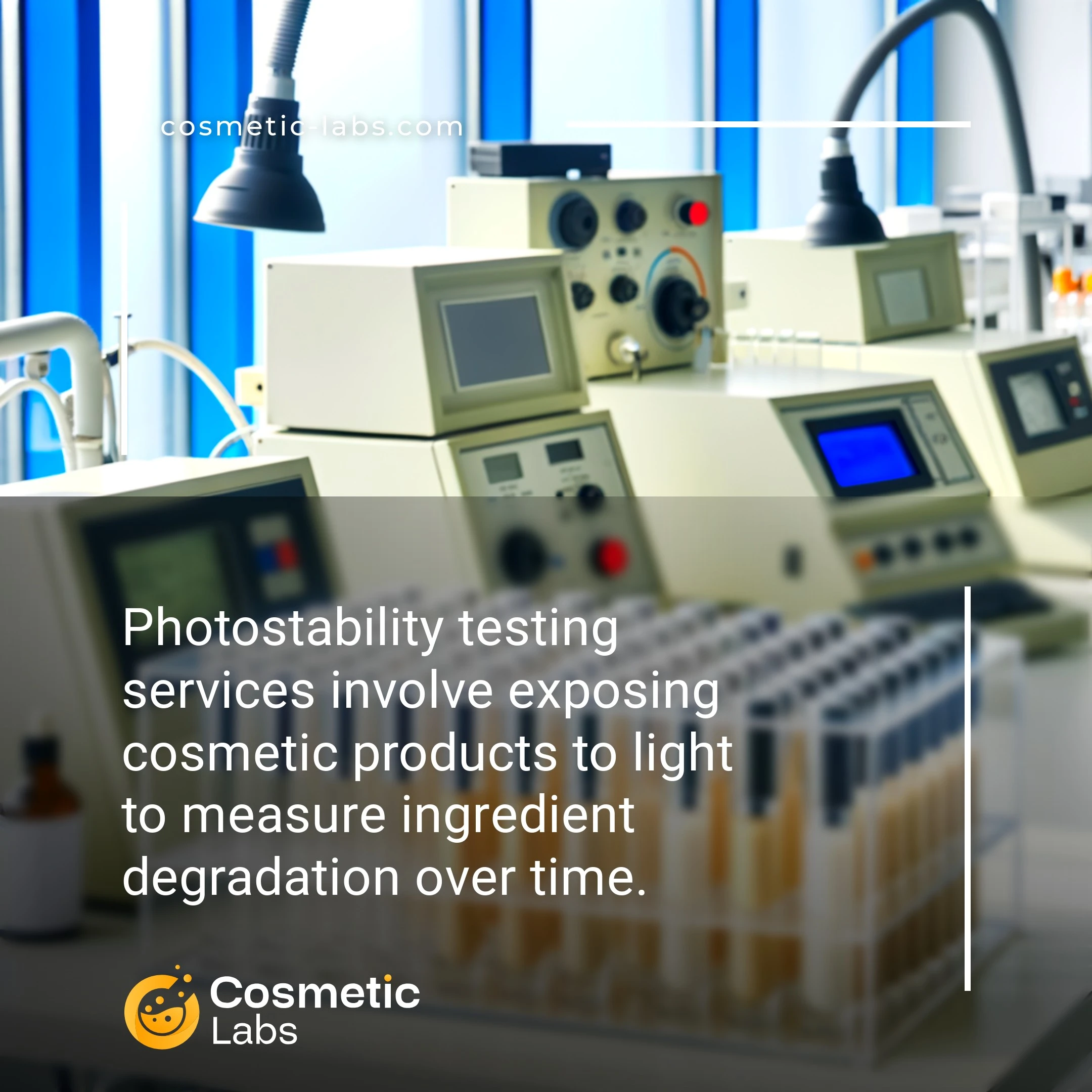Photostability Testing Services for Reliable Cosmetic Product Development

What is Photostability testing?
Photostability testing evaluates how your cosmetic formulations react to light exposure over time, measuring color changes, active ingredient degradation, and packaging performance under controlled UV and visible light conditions. Labs simulate months of shelf exposure in days using specialized chambers that mimic retail lighting and sunlight, helping you select light-protective packaging and adjust formulations before market launch. This testing catches photoinstability issues that standard stability tests miss—like vitamin C serums turning yellow or fragrances breaking down under store lights.
Why do you need this service?
Cosmetic labs apply photostability testing to predict shelf life of sunscreens and day creams under UV exposure, helping brands determine accurate expiration dates and packaging requirements. Labs also use these tests to verify color-stable formulations for lipsticks and foundations, ensuring products won’t fade or discolor in retail displays, resulting in fewer customer complaints and product returns.
Who provides Photostability testing services?
All cosmetic labs providing Photostability testing services
There is no company providing these services at the moment.
Photostability Testing for Cosmetic Products
Photostability testing determines how your cosmetic formulations react to light exposure over time. As part of preclinical compatibility testing, these services help you identify potential color changes, active ingredient degradation, and packaging interactions before your products reach consumers.
Light Exposure Testing Methods
Labs use calibrated light sources to simulate real-world conditions your products will face. Testing typically involves exposing samples to UV and visible light at controlled intensities for specific timeframes.
Standard photostability protocols include:
- ICH Q1B testing for drug-cosmetic hybrids
- UV-A and UV-B exposure assessments
- Visible light stability at 400-700nm wavelengths
- Accelerated aging under xenon arc lamps
Results show color shifts, texture changes, and active ingredient stability data within 2-4 weeks.
Packaging and Formulation Insights
Testing reveals whether your current packaging protects formulations adequately. Labs test products in their final containers alongside control samples in amber glass to measure protection levels.
Common findings that impact product development:
- Vitamin C serums losing 40% potency in clear bottles
- Natural colorants fading within 30 days of light exposure
- Fragrance compounds breaking down into skin irritants
- Preservative systems becoming less effective
This data helps you select appropriate packaging materials and adjust formulations for extended shelf life. Connect with specialized testing labs on our platform to schedule photostability assessments for your products.
Real-World Applications of Photostability Testing in Cosmetic Development
Photostability testing directly impacts product shelf life, color retention, and active ingredient performance across multiple cosmetic categories.
Sunscreen and UV Protection Products
Labs conduct photostability testing for SPF formulations to verify UV filter combinations remain effective after light exposure. Testing protocols expose products to controlled UV radiation (290-400nm) for 2-4 hours, measuring SPF degradation and photoisomerization of filters like avobenzone.
Results guide formulation adjustments—adding photostabilizers like octocrylene or switching to inherently stable filters. Labs also test packaging materials, confirming amber glass or UV-blocking plastics preserve formula integrity during 12-24 month shelf lives.
Color Cosmetics and Pigmented Formulations
Testing services evaluate pigment fade resistance in lipsticks, foundations, and eyeshadows under simulated daylight conditions. Labs use xenon arc chambers delivering 550 W/m² irradiance to replicate six months of retail display in 48-72 hours.
Color shift measurements via spectrophotometry identify unstable dyes requiring reformulation. Testing also validates antioxidant systems—tocopherols, BHT, or ascorbyl palmitate—that prevent color changes in natural pigments like carmine or beta-carotene.
| Product Type | Testing Duration | Key Parameters Measured | Common Issues Detected |
|---|---|---|---|
| Sunscreens | 2-4 hours UV exposure | SPF retention, filter stability | Avobenzone degradation, formula yellowing |
| Foundations | 48-72 hours xenon arc | Color shift (ΔE), oxidation | Titanium dioxide photocatalysis, oil rancidity |
| Vitamin C serums | 7-14 days ambient light | Ascorbic acid content, pH | Oxidation to dehydroascorbic acid |
| Natural extracts | 24-48 hours full spectrum | Antioxidant activity, color | Polyphenol degradation, browning |
Connect with specialized labs on our platform to implement photostability testing protocols tailored to your specific formulation challenges and regulatory requirements.
